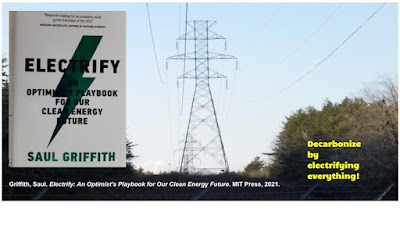This post continues a series of articles that present an optimistic playbook to combat the consequences of climate change being experienced by the world today.
Saul Griffith, inventor, entrepreneur, and engineer is the founder of Rewiring America, a nonprofit dedicated to decarbonizing America by electrifying everything. He was the recipient of a MacArthur Fellowship “Genius Grant'' in 2007. He offers an optimistic plan to address climate change.
Some of the benefits of an engineering analysis of the climate crisis, like that offered by Saul Griffin in his 2021 book, Electrify: An Optimist's Playbook for Our Clean Energy Future, include experience differentiating efficiency benefits and transformation benefits using calculations of energy use.
It’s not the 1970’s anymore and we are not facing a 70’s energy problem that can be solved with efficiency. We need transformation.
70’s thinking focuses on lots of small decisions and distracts us from the big picture.
70’s thinking muddles thermodynamic efficiency with energy saved through behavior change.
70’s thinking leads to a narrative of deprivation.
70’s thinking is about doing less bad, not about doing more good and building good into the way we do everything (Griffith, 2021, p47)
Comparisons of electrical transportation and heating/cooling systems to existing fossil fuel technologies require engineering quality efficiency calculations.
In an electric car, we take electricity, store it in a battery, (approx 90% efficient), and then pass it through a drivetrain (approx 80% efficient).
Total efficiency = 1x0.9x0.8=0.72
We get 0.72 units of transportation for one unit of electricity.
If we use the same electricity to make hydrogen (via electrolysis, approx 65% efficient), then compress it into a tank and decompress it back out, (approx 75% efficient), then run it through a fuel cell (approx 50% efficient),
Total efficiency = 1x0.65x0.75x0.5=0.24
We get only 0.24 units of transportation for the same one unit of electricity (Griffith, 2021, p52)
Proposals to supply fossil fuel free energy and use innovative technology to capture and sequester carbon dioxide need to be assessed with the engineering calculation of EROI, Energy Returned on Energy Invested.
One unit of fossil fuel in gets you 7 or 8 units back… Estimates vary but wind and solar provide approximately twice the EROI of fossil fuel power plants. As manufacturers reduce the energy input of producing wind and solar technology, and as engineers extend the useful lifetime of this green machinery, the advantage will only improve. (Griffith, 2021, p59)
Griffin estimates that when we add up all the energy savings of electrification we will find that we only need approximately 42% of the primary energy we use today.
Winning the war against the climate crisis will also mean a cleaner, more positive future. Our homes will be more comfortable when we shift to heat pumps and radiant heating systems that can also store energy. While it may be desirable to downsize our homes and cars, this isn’t absolutely necessary, at least in the US. Our cars can be sportier when they are electric. Household air quality will improve, as will public health, since gas stoves raise the risk of asthma and respiratory illnesses. We don’t need to switch to mass rail and public transit, nor mandate changing the settings on consumers' thermostats, nor ask all red-meat loving Americans to turn vegetarian… And if we successfully employ biofuels, we don’t have to ban flying. (Griffith, 2021, p61)
The engineering analysis of “Is it ready to go to scale today?” is crucial to avoid using resources on solutions that will come too late.
There will be trade-offs. More nuclear means fewer batteries but more public resistance and, most likely, higher costs. More solar and wind means more land use. What we cannot afford are plans that make no progress because we are wasting time arguing over these issues before we begin, or because we are over-investing in technologies that can’t scale up sufficiently. The real test, given the urgency of our climate situation, should be, “Is it ready to go to scale today?” We need to act now. (Griffith, 2021, p73)
Time to project completion is a key engineering parameter that must be considered in this decade for action to mitigate the worst impacts of climate emergency.
References
Griffith, S. (2021). Electrify: An Optimist's Playbook for Our Clean Energy Future. MIT Press.


No comments:
Post a Comment